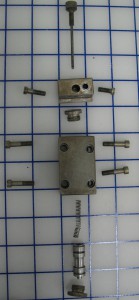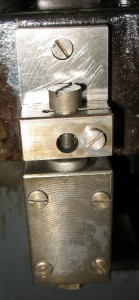Last but not least of the control valves to be serviced on my Monotype caster is what I refer to as the Mould Signalling control valve. Depending on what options the caster is fitted with, this valve might be used for casting low quads (rather than having the bridge detect the special quad mats which have a shallow cone hole for the centering pin), or for controlling one part of the mould blade when using a duplex or triplex mould. Some features require additional pneumatic mould control, so if you have a triplex mould or want low quads from a duplex mould, your caster would have a second (essentially identical except for choices of air lines) mould control valve beside this one, and for the triplex mould and the high-quad shutter used in mathematical setting, the Unit Adding control valve is also co-opted.
 This valve (and its twin if secondary mould control is installed) are quite simple: Signalling the N air line not only raises the N air pin, but also diverts the 0075 signal from the 0075 air pin to the mould signalling line (secondary mould control uses 0005). A rod screwed into the top of the valve prevents it from moving if this operation is not wanted (in which case the N+0005 and N+0075 would act just like 0005 and 0075, causing the justification wedges to be set, turning off the pump, and/or causing the galley to operate, as appropriate).
This valve (and its twin if secondary mould control is installed) are quite simple: Signalling the N air line not only raises the N air pin, but also diverts the 0075 signal from the 0075 air pin to the mould signalling line (secondary mould control uses 0005). A rod screwed into the top of the valve prevents it from moving if this operation is not wanted (in which case the N+0005 and N+0075 would act just like 0005 and 0075, causing the justification wedges to be set, turning off the pump, and/or causing the galley to operate, as appropriate).
At least, that is according to the ‘Monotype’ Composition Caster Manual. On my caster, the H and J lines are used instead of N and 0075, respectively, and I still don’t understand why. As a result of this, signalling the mould also raises the H air pin. If the signalling is used to select low quads, it doesn’t really matter which air pin pops up in the rear pin block, and it could be argued that H centers the matcase, producing on average a minuscule reduction in wear and noise when the matcase is positioned for the next character. But for use with a duplex or triplex mould, this limits casting to columns NI through H of the matcase when the mould is signaled (either regular or secondary).
In any case, I have reassembled this valve, putting the bent end of the spring inside the piston so it can’t jam when the piston moves, and reinstalled it on the caster. With all the control valves back in place I have to solve my other pneumatic woes: air leaks and stuck air pins.


Leave a Reply